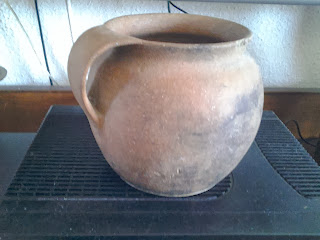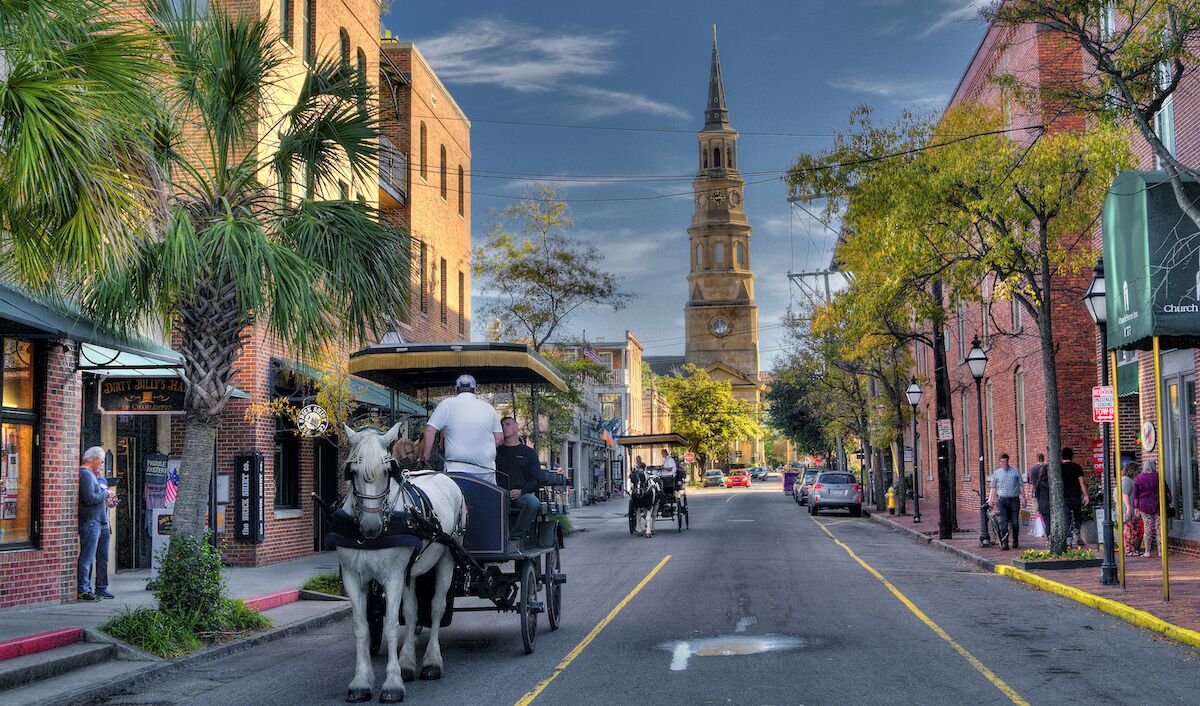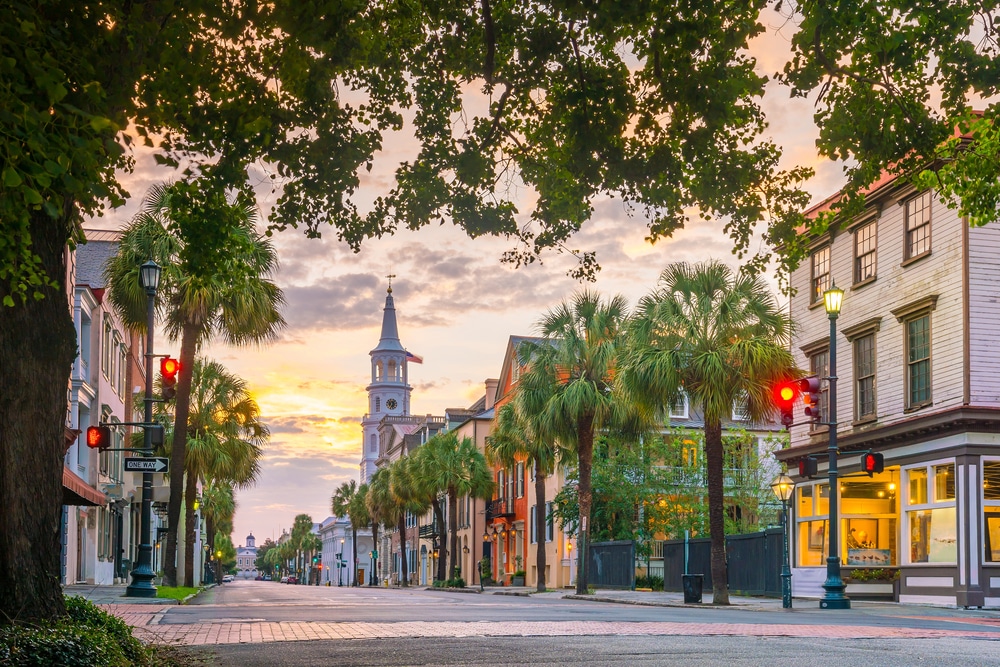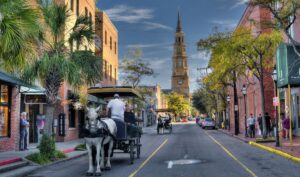 |
| Colonoware vessel, Georgia ca 1750 |
primary find at archaeological digs. They are important in determining the economic status, food ways and eating habits of those that lived there.
In colonial digs here in Charleston, , early porcelain shards from Germany and England are
common, reflecting Charleston’s status as the major seaport on the eastern seaboard. Late
colonial and antebellum digs reveal the Chinese Export porcelain so cherished
and displayed today in the china cabinets of many an Old Charleston family.
Occasionally, the alkaline glazed stoneware
produced in the upstate of South Carolina is to be found in post -1820
sites. These ceramics are thoroughly documented.
Mixed among the shards are
another ceramic not so well documented , and it is dubbed Colonoware. Colonoware is a hand coiled and
pit fired pottery long produced as an inexpensive trade item by American Indians and sold or bartered in the city. It is never found stashed in the back of barns, or at estate sales. It is never found passed down as precious family heirlooms. It is commonly found at dig sites of 18th century pioneer settlements and at 18th and 19th century plantation communities. Normally found as broken shards, intact specimens are recovered from riverbeds. Since trade goods were transported by water, the occasional overturned boat provides intact specimens. The example below was recovered from the Savannah River.(see Figure 1 below).
As the Indians were dispersed from the southeast, it
appears that Colonoware production was taken up by plantation blacks to provide cooking and eating vessels. This is a practice most likely encouraged by plantation owners. It was, after all, an inexpensive source of cooking and eating ware that put elderly or substantially disabled hands back to work.
Typically, plantation slaves would have prepared
food in a common pot. The food would have been transferred from the pot to a
large wooden communal bowl for serving and eating. Eighteenth century digs at
plantation sites where slaves lived reveals little in the way of serving spoons
or cutlery of any sort. Most white frontiersman were eating with wooden spoons,
and this was probably the norm for slaves as well, Although the archaeological
record is silent . we do know that they were not eating with metal implements..
As pewter became available, it use was reserved initially for whites. Thus, for
the first half of the eighteenth century many plantation slaves would have eaten
without utensils, using shells or makeshift items. From the cooking pot, the food would be transferred to a
community bowl or trough where it would be shared by all, or the food would be transferred
into small bowls or pots, such as the colonoware bowl here illustrated.
 |
| Classic cooking bowl form |
Some scholars suggest that Colonoware was folk craft handed
down from Africa. There are certainly precedents. Similar coiled and low fired
ware was produced in Africa, as it was in virtually all cultures. Indeed, more
sophisticated high fired wares were produced in Africa and all over the world. Whatever its origin, we know that the Catawba Tribe was trading in Colonoware well into the nineteenth century, wares that were used on the plantation by
slaves. Colonoware shards from the earliest sites reflect the aboriginal styles of the native Indians, but it was not long before the ware produced for sale took on the look of European vessels such as the one pictured above..
of the Driver”, author William Gilmore Simms notes that during his boyhood in
the 1810s that
It was the custom of the Catawba Indians …to come down, at
certain seasons, from their far homes in the interior, to the seaboard,
bringing to Charleston a little stock of earthen pots and pans….which they
bartered in the city. They did not, however, bring their pots and pans from the
Nation, but descending to the Lowcountry empty handed, in groups or families,
they squatted down on the rich clay lands of the Edisto and and there established
themselves in a temporary abiding place, until their simple potteries had
yielded them a sufficient supply of wares with which to throw themselves into
the market.”
That colonoware was produced for the slave population can be
inferred by the statement of Phillip Porcher, a St Stephens SC resident ,
recounting that :
“….the Catawba Indians ….traveled down from the upcountry to
Charleston, making clay ware for the negroes along the way. They would camp until
a section was supplied and then move until finally Charleston was reached.”
interview in 1935 recalling plantation days of the 1850s said:
“De Indians fetch their pots and jars to sell”
Note that by this time , (1850s) exceptional high fired
utilitarian stoneware was being produced and sold in the Winnsboro area. The
stoneware, with a glassy alkaline glaze, was both durable and easy to clean. It
was used for food production but also for serving as well, although fancy ware from Charleston was preferred at the dining table by country housewives who could afford it. By this time tinsmiths were producing plates
and cups in the upcountry and rail was bringing goods inland from the coast. Apparently,
the use of these items were reserved for the white population, and colonoware
use was reserved for the slave population.
Below are examples of contemporary Catawba Pottery. This is a highly collectible product that is different than the Colonoware produced for trade
.
Figure 2. Contemporary Catawba Ware
 |
| Contemporary Catawba Pottery |
Because Colonoware was a low fired product it was delicate,
not unlike porcelain. Unlike porcelain,
this porous and unglazed product stained
easily and would have retained flavors from previous use. It
would not have been uniformly sanitary after cleaning and would have
been a breeding ground for microbes It seems that its major advantage was low
cost. I suspect that, in its own way,it
was a symbol of repression. Colonoware
was an inferior product, a fact perhaps not noted by the 18th
century slave population , but certainly by nineteenth century slaves observing the expansion of ceramic and tin options. As food preparation and serving vessels improved with the introduction of tin and stoneware, colonoware continued as
the Master’s choice for the slave street.
shards at dig sites all throughout the southeast from Florida to Alabama to
Virginia. Shards are commonly found interspersed among other shards in
archaeological digs. Present in both eighteenth and nineteenth century digs, it
is far more predominant in earlier sites than later. It is interesting to note
that it is virtually nonexistent at post civil war sites.
society left colonoware behind when allowed to choose their own vessels.
l










